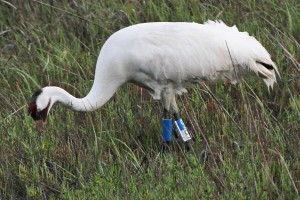By: Aaron Pearse, USGS Northern Prairie Wildlife Research Center and Brad Strobel, USFWS, Aransas Wildlife Refuge
Since 2009, a partnership of agencies and organizations has been conducting research on the Aransas‐Wood Buffalo population of Whooping Cranes. Fundamental objectives of our research efforts are: 1) to advance knowledge of Whooping Crane breeding, wintering, and migratory ecology, including threats to survival and population persistence; 2) to disseminate research findings in reports, presentations, and peer‐reviewed literature to provide reliable scientific knowledge for conservation, management, and recovery of Whooping Cranes; and 3) to minimize negative effects of research activities to Whooping Cranes.
Funds and personnel in support of this endeavor are being contributed by the Canadian Wildlife Service, The Crane Trust, Plate River Recovery Implementation Program, U.S. Fish and Wildlife Service, U.S. Geological Survey, Parks Canada, International Crane Foundation, and Gulf Coast Bird Observatory.
To meet objectives, members of the partnership have captured and marked 35 Whooping Cranes. We captured one juvenile and two adults along the Gulf Coast of Texas during winters 2009 and 2010. Capture teams marked nine juveniles during August 2010 and 12 juveniles during August 2011 at Wood Buffalo National Park in Canada. In December 2011, we successfully captured and marked 11 cranes on Aransas National Wildlife Refuge, eight of which were known or suspected paired adults.
Capture teams consist of individuals with experience handling and marking endangered cranes. At capture, a licensed veterinarian performs a health check on each crane, which includes an external examination and screenings for pathogens, toxins, and parasites. We affix all captured cranes with a satellite transmitter (Platform Transmitting Terminal) with Global Positioning System capabilities mounted on a two‐piece leg band. The transmitter and leg band weigh approximately 72 g, which is <1.5% of body weight of adult cranes.
Integrated solar panels on all exposed surfaces allow transmitters to function for approximately three to five years. Transmitters record GPS locations every six hours, providing detailed information on nocturnal and diurnal site use and general flight paths.
Approximately every 56 hours, transmitters upload new data, which assists in identifying mortality events when possible.
We have been collecting location data on marked birds since December 2009 and expect data collection to continue for at least the next three years. As our sample of marked cranes has expanded in 2011, expectation among research partners has increased as we begin to explore the volume of rich information provided by marked individuals. Partners agree that this opportunity to mark wild Whooping Cranes with GPS technology represents an exceptional prospect to enhance our understanding of whooping Cranes and assess risks they face during their entire life cycle.
Article from The Unison Call, newsletter of the North American Crane Working Group


